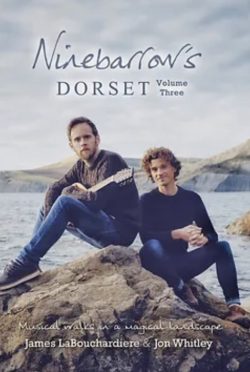 DORSET’s much-loved folk duo Ninebarrow – James LaBouchardiere and Jon Whitley – are almost as well known for their love of walking as they are for their beautiful harmonies and charming original songs. For some years they have been leading walks and writing books to introduce their fans and fellow-walkers to different areas of their home county, which inspires so much of their music.
DORSET’s much-loved folk duo Ninebarrow – James LaBouchardiere and Jon Whitley – are almost as well known for their love of walking as they are for their beautiful harmonies and charming original songs. For some years they have been leading walks and writing books to introduce their fans and fellow-walkers to different areas of their home county, which inspires so much of their music.
They have now published their third volume of “musical walks” containing ten routes in some of Dorset’s most spectacular and exciting scenery – the dramatic Purbeck coastline, the ancient hillforts and the mysterious landscape of Cranborne Chase where you can find traces of human activity that date back many millennia. The duo even took their name from a famous landmark – Nine Barrow Down in the Purbecks.
It is some years now since Jon and Jay gave up their day jobs (Jon was a teacher and Jay was a GP) to become full time musicians. That decision has paid off, with a string of critically acclaimed albums – the most recent is their fifth, The Colour of Night – as well as two books of walks, and a sideline in organising musical walking holidays, which combine three days of walking with fine food and evening concerts.
Walking is an essential part of their lives: “The outdoors is our muse,” says Jon. “For Jay and I, walking is a creative experience. We never feel more creative than when we’re out hiking.”
There is certainly plenty to inspire your imagination in these walks, which are graded from easy to moderate to challenging to hard, and are mostly around five to six miles. The ten routes are: Hambledon Hill and Hod Hill; Badbury Rings; Martin Down; Ballard Down; Ringstead and White Nothe; Lulworth Cove and Mupe Bay; Lyscombe Bottom; Duncliffe Hill; Cerne Abbas; and Tynehgam and Kimmeridge.
The walks are well-researched and described, both in words and in beautiful photographs. There are clear maps and directions, and advice on such basic facts as availability of loos, where to leave your car and where you can find refreshment on or after your walk. There are also handwritten side-bars giving additional information on such features as medieval lynchets, Iron Age hill-forts, the origin of place names or what you can see from a particular high-point.
The book is a handy size that would fit in a pocket or backpack and a sensible, strong plastic cover. It all adds up to a very useful addition to the walking library of anyone who loves Dorset – and if you don’t already know it, it should also encourage you to listen to Ninebarrow’s music. For more details of the book and their albums, visit www.ninebarrow.co.uk